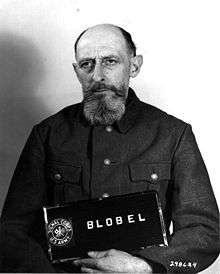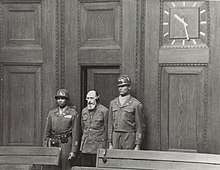Paul Blobel
Paul Blobel (13 August 1894 – 7 June 1951) was a German SS commander and convicted war criminal. He was the key figure in organising and executing the Babi Yar massacre of 1941. In June 1942, Blobel was put in charge of Sonderaktion 1005, with the task of destroying the evidence of Nazi atrocities in Eastern Europe. After the war, he was convicted at the Einsatzgruppen Trial and executed.
Paul Blobel | |
|---|---|
 Blobel in custody, 1948 | |
| Born | 13 August 1894 |
| Died | 7 June 1951 (aged 56) |
| Known for | |
| Criminal charge | Crimes against humanity |
| Trial | Einsatzgruppen Trial |
| Penalty | Death penalty |
| SS career | |
| Allegiance | |
| Service/ | |
| Rank | Standartenführer |
| Commands held |
|
Early life
Born in the city of Potsdam, Blobel fought in the First World War, in which by all accounts he served well, being decorated with the Iron Cross first class. After the war, Blobel studied architecture and practiced this profession from 1924 until 1931, when upon losing his job he joined the Nazi Party, the SA, and the SS (he had joined all of these by 1 December 1931).[1]
SS career
.jpg)
In 1933 Blobel joined the police force in Düsseldorf. In June 1934 he was recruited into the SD Security Service. During World War II, following Operation Barbarossa, in June 1941 Blobel became the commanding officer of Sonderkommando 4a of Einsatzgruppe C, active in Reichskommissariat Ukraine. Both, Einsatzgruppen and the Order Police battalions were responsible for massacres of Jews behind the Wehrmacht lines in the Soviet Union. The murder campaign included all political and racial undesirables. In August 1941 Blobel was put in charge of creating a Nazi ghetto in Zhytomyr to enclose around 3,000 Jews who were murdered a month later.[2]
On 10 or 11 August 1941, Friedrich Jeckeln ordered him, on behalf of Adolf Hitler, to exterminate the entire Jewish population.[3] On 22 August 1941, the Sonderkommando murdered Jewish women and children at Bila Tserkva with the consent of Field Marshal Walther von Reichenau, commander of the 6th Army. SS-Obersturmführer August Häfner testified at his own 1942 trial:[4]
The Wehrmacht had already dug a grave. The children were brought along in a tractor. The Ukrainians were standing around trembling. The children were taken down from the tractor. They were lined up along the top of the grave and shot so that they fell into it. The Ukrainians did not aim at any particular part of the body. ... The wailing was indescribable.[4]:217
Blobel, in conjunction with Reichenau's and Friedrich Jeckeln's units, organised the Babi Yar massacre in late September 1941 in Kiev,[5] where 33,771 Jews were murdered.[6] In November 1941, Blobel received and activated the first gas vans at Poltava.[4]:234
Blobel was relieved of his command on 13 January 1942, officially for health reasons, but mostly due to his alcoholism. In June 1942 he was put in charge of Aktion 1005, with the task of destroying the evidence of all Nazi atrocities in Eastern Europe. This entailed exhumation of mass graves, then incinerating the bodies. Blobel developed efficient disposal techniques such as alternating layers of bodies with firewood on a frame of iron rails.[4]
In October 1944 he headed an anti-partisan group in Yugoslavia. Gitta Sereny related the conversation about Blobel she once had with one-time Chief of the Church Information Branch at the Reich Security Head Office, Albert Hartl.
Hartl had told me of a summer evening—that same hot summer in 1942—in Kiev when he was invited to dine with the local Higher SS Police Chief and Brigadeführer, Max Thomas. A fellow guest, SS Colonel Paul Blobel, had driven him to the general's weekend dacha. "At one moment—it was just getting dark," said Hartl, "we were driving past a long ravine. I noticed strange movements of the earth. Clumps of earth rose into the air as if by their own propulsion—and there was smoke; it was like a low-toned volcano; as if there was burning lava just beneath the earth. Blobel laughed, made a gesture with his arm pointing back along the road and ahead, all along the ravine—the ravine of Babi Yar—and said, 'Here lie my thirty-thousand Jews.'"[7]
Trial and conviction

Up to 59,018 killings are attributable to Blobel, though during testimony he was alleged to have killed 10,000–15,000 people. He was later sentenced to death by the U.S. Nuremberg Military Tribunal in the Einsatzgruppen trial. He was hanged at Landsberg Prison shortly after midnight on June 7, 1951.[8]
In the media
- Blobel was portrayed by actor T. P. McKenna in the 1978 miniseries Holocaust.
- Blobel is an historical character in Herman Wouk's book War and Remembrance. He was portrayed by actor Kenneth Colley in the television adaptation of the book.
References
- Zentner, Christian Ed; Bedürftig, Friedemann Ed (1991). The Encyclopedia of the Third Reich. New York: Macmillan. p. 1150. ISBN 0-02-897502-2.
- Ogorreck, Ralf (2010). Les Einsatzgruppen, Tallandier, p. 150, ISBN 978-2-286-03062-9
- Ogorreck, Ralf, op. cit. p. 203.
- Friedländer, Saul (2007). The Years of Extermination: Nazi Germany and the Jews, 1939–1945. HarperCollins. ISBN 978-0-06-019043-9.
- Christopher Browning: The Origins of the Final Solution: The Evolution of Nazi Jewish Policy, September 1939 – March 1942 (With contributions by Jürgen Matthäus), Lincoln: University of Nebraska Press, 2004. pp. 291–292 ISBN 0-803-25979-4 OCLC 52838928
- 1941: Mass Murder The Holocaust Chronicle. p. 270
- Sereny, Gitta (1974). Into That Darkness: From Mercy Killing to Mass Murder (2005 paperback ed.). London: Pimlico. p. 97. ISBN 978-0-7126-7447-8. Sereny also mentions the story in her 1995 biography of Albert Speer: Sereny, Gitta. Albert Speer: His Battle With Truth (1996 paperback ed.). London: Picador. p. 272. ISBN 978-0-330-34697-9.
- "Five death sentences were confirmed: the sentence against Oswald Pohl, as well as those passed against the leaders of the Mobile Killing Units, Paul Blobel, Werner Braune, Erich Neumann and Otto Ohrlendorf. ... In the early morning hours of 7 June, the [] Nazi criminals were hanged in the Landesburg prison courtyard." Norbert Frei, Adenauer's Germany and the Nazi Past: The Politics of Amnesty and Integration. Columbia University Press, 2002. p. 165 and p. 173
| Wikiquote has quotations related to: Paul Blobel |